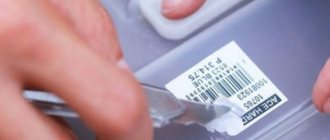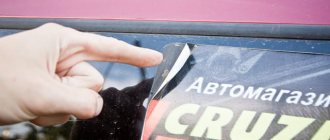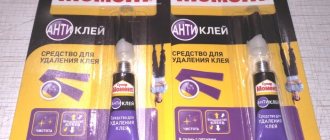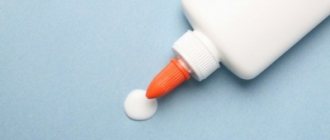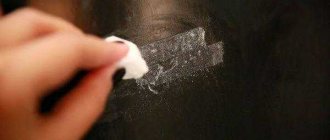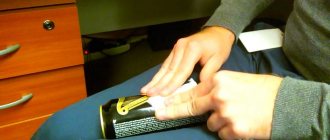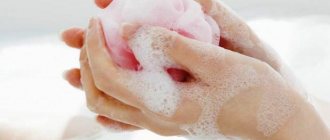Today you can hardly find a household appliance or other item that is sold in a store without stickers, sticky price tags and advertisements. In addition, there are special protective films. Beautiful, bright and modern! However, it is simply impossible to remove such delights from the surface of an object. Happened? Look at the place where it was glued. There you will definitely see a trace left from the adhesive base. Then you need to know what and how to properly remove stickers from different surfaces without damaging the item.
How to remove glue from dishes
There are almost always stickers on the bottom of plates or other utensils. The surface of the products cannot be called too fragile, so some people prefer to remove stickers mechanically. To do this, place the plates in water so that the price tag softens properly, after which the glue is scraped off with a knife.
But this is an outdated method, and it is better to avoid using it, since the surface will be scratched in any case. Essential oils (eucalyptus, tea tree) will help remove glue from dishes.
It is enough to apply a few drops on the price tag and wipe it with a clean, dry cloth. Traces of glue will disappear within a few minutes. After this, you need to wash the plate using dishwashing detergent.
Since not every person has essential oils at home, you can get rid of the sticker using vegetable oil.
To do this, you need to tear off the label as much as possible with your hands, then soak a cotton swab in the product and rub the remaining glue and paper.
Baking soda, from which you need to prepare a solution, will also be of great help. At 5 l. water should be diluted with 150 g. powder, and soak the plate with the price tag in the resulting composition for 30 minutes. After half an hour, take out the plate, the label will fall off by itself.
To prevent price tags from peeling off and getting lost during transportation, product manufacturers use powerful adhesive that is not at all easy to remove. The task becomes more difficult if sticky residues need to be washed off delicate surfaces. But with sufficient desire and perseverance, it is quite possible to do this, even if you have to apply the methods more than once.
Types of stickers
Stickers come in paper and polymer types; they need to be removed in different ways.
Paper based
To remove the paper sticker, simply moisten it with warm water. After 3–5 minutes, wipe the soaked base with a sponge and remove any remaining glue using washing powder.
To remove a laminated sticker, remove the film, then wet the label with water.
Polymer based
A polymer sticker is more elastic than paper and melts at high temperatures. To remove the sticker, you need to peel off the transparent film and remove traces of glue using dishwashing detergent. If the label is difficult to remove, heat it with a hot hairdryer.
How to remove stickers from different surfaces?
Today you can hardly find a household appliance or other item that is sold in a store without stickers, sticky price tags and advertisements. In addition, there are special protective films. Beautiful, bright and modern! However, it is simply impossible to remove such delights from the surface of an object. Happened? Look at the place where it was glued. There you will definitely see a trace left from the adhesive base. Then you need to know what and how to properly remove stickers from different surfaces without damaging the item.
Rules for removing adhesive stains
It is advisable to remove the glue from the sticker immediately. There is no need to wait until dust gets on the layer: this will make it more difficult to deal with the sticky mass. If traces of glue have become dirty, hardened, and removing the stain is no longer so easy, you can use several methods to be more effective. The main thing is to monitor the condition of the surface so as not to spoil the item.
To remove label residues, chemicals are often used that can damage the coating. Aggressive substances easily damage plastic, varnish and paint. First, test the products on an inconspicuous area of the item. When working with chemicals, be sure to protect your hands, face, eyes and respiratory tract to avoid poisoning. Use toxic substances - gasoline, solvent - in ventilated areas.
On a note! Cover the surface around the sticky layer with masking tape, and during the processing you will not stain clean areas.
Take safety precautions when using electrical tools to remove the sticker. Also be careful when removing label adhesive from household appliances. Turn off the appliances being cleaned to avoid electric shock.
What means can you use to remove stickers?
Sunflower oil (or any vegetable oil that does not have color); Mayonnaise; Alcohol-containing substances; Ammonia; Esters of vegetable oils; Cleaning agents containing a lot of citrus fruits; Nail polish remover; Aviation gasoline, lighter fluid; Glass cleaner; Special spray for cleaning sticky components; Hairdryer; Melamine sponge; A piece of foam rubber; Soft cloth; Any unnecessary plastic card; Iron; Blank sheets of paper.
Mechanical cleaning by hand
Manual cleaning is most often used either due to the lack of special detergents and compounds, or when it is impossible to use chemical cleaners.
Also a major factor for using manual cleaning is the risk of surface damage.
To manually remove stickers, you can use any of the available means - napkins, dish sponges. During such cleaning, you should carefully monitor the degree of impact on the surface being cleaned, avoiding excessive zeal, in which case you will be able to achieve the best result.
Regardless of whether any specific product is used to remove stickers and adhesive residues, or whether manual cleaning is performed, following the tips offered in this material, you can achieve the main thing - permanently peel off the sticker without leaving a trace.
Now you know everything about removing sticky residue from stickers.
How to remove sticky sticker residue?
There are several options for removing adhesive residue from stickers. The required option can be selected depending on the surface of the product.
Peeling off
We will use this method if the sticker is not firmly glued to the product. The main part of it is carefully removed, the remnants are rolled with dry fingers into small twists and removed from the surface. Try not to scratch the remaining substance with your nails to avoid damaging the product. If you are unable to get rid of the sticker this way, proceed to the options described below.
Vegetable oil
For this purpose, take any vegetable oil. Both regular sunflower and corn, olive or cotton are great. The method of using the product is simple:
Dip a piece of soft cotton cloth into oil; Treat the sticker stain; Wait 10 minutes for the glue components to soak in the oil; Clean off any residue with a plastic card or the back (dull) side of a knife blade; Wipe the treated area with a cloth soaked in water and detergent.
This method is great for products coated with a layer of paint or varnished wooden surfaces. Instead of vegetable oil, you can use mayonnaise.
It is great to remove glue residues using any essential oil. You can take castor oil, burdock oil, sea buckthorn oil or avocado oil, the result will be the same.
So, the sequence of actions is as follows:
Apply ether to the sticker stain; Distribute it over the entire stained surface; Leave for 10 minutes; Using a soft cloth, roll up the remainder in a zigzag motion; Take a paper napkin and wipe the work area; Finally, spray the area with any glass cleaning liquid and wipe dry.
Before using these substances, be sure to test the underside of the product to ensure that the substances do not leave stains.
Citrus
Each citrus-based product contains citric acid granules. They help to corrode the remaining glue and easily remove it from the surface. It is better to use products in the form of gels or sprays.
Apply the substance to the stain and leave for a few minutes; Wipe with a dry cloth or paper napkin; Wipe with water and a small amount of detergent; Apply polish (if necessary).
Alcohol (96%) medical
It's no secret that this substance has remarkable cleaning properties. The same applies to alcohol-containing substances - colognes, perfumes, vodka, deodorants.
Take a sponge; Soak it in the selected substance; Wipe the surface.
Be sure to test the alcohol-containing substance on the back of the product. Alcohol may react with the finish of the product and leave stains.
Using regular masking tape, you can quickly remove sticker residue from flat surfaces. This method works especially well in the case of fresh stains:
Remove the sticker; Place a piece of masking tape with the adhesive surface on the remaining stain; Leave the “tail” of the tape in your hand so that you can grab it tightly; With a sharp upward movement, tear the tape off the surface; If necessary, repeat the process with a new piece of tape.
Remove any remaining glue using a damp cloth. Wipe with a dry cloth.
Vinegar 9%
To remove sticker residue from various surfaces, use regular food vinegar.
Take a piece of foam rubber; Dip it in vinegar; Apply the product to the glue; Leave for 10 minutes; Using a plastic card, remove any remaining adhesive from the surface of the product; Treat the area with a soft, damp cloth; Wipe dry with a napkin.
Kerosene or lighter fluid
Use these products with caution on acrylic painted and polished surfaces. Kerosene is an active solvent and can ruin your item.
Dampen a soft cloth with the product; Use circular movements to remove glue from the product; Treat the area with a damp cloth and detergent; Wipe with a clean cloth soaked in water; Dry with a napkin.
To remove old stains from the sticker, use a regular hair dryer. The hot air will melt the remaining adhesive and you can remove them using a plastic card:
Turn on the hair dryer at medium power; Bring it to the stain at a distance of 10 centimeters; Gently heat the remaining glue; Scrape with a plastic card; Take a soft rag, soak it in any vegetable oil; Wipe off any remaining adhesive; Wash the area with a cloth and soap; Wipe with a dry cloth.
This product cannot be used on plastic surfaces. When exposed to hot air, the item will become deformed or burst. In addition, thermal exposure is not recommended for lacquered or glass surfaces.
If the sticker stain is fresh, you can use regular wet wipes. Work the area in a circular motion until the residue is completely gone.
Nail polish remover (no acetone)
A nail polish remover solution and a hairdryer will help remove the price tag from a paper or cardboard surface:
Using a hair dryer, heat the area with the remaining adhesive; Scrape off the adhesive using a plastic card; Wipe the area with a sponge soaked in nail polish remover.
You only need to apply a small amount of product onto a cloth or sponge. Otherwise, you risk damaging the product box.
This product is excellent at removing sticker stains from any surface. For example, from glass:
Wet the surface of the product with water; Press the corner of the sponge firmly onto the surface of the product; Scrub the glue in a circular motion; Clean the surface of glue residues using vegetable oil; Wipe with a cloth soaked in soapy water; Wipe dry with a napkin.
Do not use this product on items that will contain food.
Sticker Remover Spray
Currently, there are special substances that are designed to remove adhesive residues from various surfaces. Before using this substance, you must carefully read the instructions for use. It indicates what surfaces it is intended for, contraindications for use and possible consequences.
Tools at hand: 11 tricks
For many cases, simple methods and means that are always at hand will do. This is convenient at home. And you won't have to spend extra money.
Mechanical cleaning by hand
Sometimes the price tag can be easily removed by hand. If there is a mark left, you need to rub it with your finger: roll the glue into rolls and shake it off. If necessary, wipe the plastic surface with a damp soapy sponge.
Scraper or plastic card
First, thoroughly wet the sticker with water. Then carefully clean it off with a scraper.
If you don’t have a scraper, a plastic card will help you wipe off the price tag. Surely there is at least one that you wouldn’t mind using.
Vegetable oil
Fat dissolves glue well. Sunflower, olive, rapeseed and other vegetable oils are suitable. How to remove a label: you need to soak it in fat, leave it for at least 15 minutes and remove it with a plastic card, a scraper, or a rubber spatula.
Mayonnaise is also suitable, because it contains vegetable oil.
Essential oil
We proceed as in the previous recipe. By the way, the remaining oil is removed with baking soda: it absorbs fat well. Then wipe with a cloth - dry or damp with soap.
Peanut butter
Peanut butter will help peel off the price tag. Apply a little to the desired area and leave for a few minutes. Afterwards we wash it with a soapy sponge.
Soda
Add some water to baking soda. Apply the resulting paste to the label and wipe with a cloth or sponge.
In more difficult cases, leave the wet soda for 5 minutes after application. Then we peel off the sticker and rinse with warm water.
How can you strengthen soda? Vegetable oil. Apply the mixture to the sticker and erase it after a few minutes.
Lemon
Lemon juice is good at removing glue. Take a piece of lemon and squeeze the juice onto the price tag. We wait 3–5 minutes. Remove the sticker and wash the surface with warm water.
Detergents containing citric acid are also suitable.
Vinegar
It’s good to peel off price tags with 9% table vinegar. We process the desired area and wait 3-10 minutes, then remove it without any residue.
Carefully! Vinegar may damage the plastic slightly. If appearance is important, then first test the method on a small, inconspicuous fragment.
Melamine sponge
A melamine sponge will help you remove the price tag without leaving marks. Just wet the label and wipe it off with a sponge.
Carefully! Not suitable for handling dishes and requires working with gloves due to the content of harmful substances in the composition.
Heating with a hairdryer
First, warm up the sticker with a hairdryer, and then remove it. You can pry the paper with your fingernail or knife. If it doesn’t work the first time, then repeat the procedure.
Important! Evaluate the strength of the plastic: how hot air it can withstand.
Steam cleaning
The method is only suitable for plastic that does not deform from high temperature. You will need to keep the surface with the label over steam for 2–5 minutes. Afterwards the sticker will easily come off on its own. You won't have to think about how to tear it off.
You can use a steam generator, a steamer, an iron with a steamer, or a boiling kettle. We steam the sticker and then wash it off with a soapy sponge.
Removing stickers from clothes
Manufacturers often put labels or stickers on clothes. In addition, some stores do not stand on ceremony, and sticky price tags end up glued directly to clothes. Removing such “art” is difficult, but possible. To do this, use the following tips:
Hot water and laundry soap
Soak the item (if the quality of the fabric allows it) in hot water. Wash the sticker area with laundry soap. Leave to soak for half an hour. Wash the fabric and rinse with warm water. If necessary, repeat the procedure again.
Currently, you can buy a special spray in stores for quick dry cleaning of collars and cuffs. This product is also suitable for cleaning contaminated surfaces of the product. It can remove even old sticker stains without affecting the external characteristics of the product at all. It works equally well on both plain and colored fabrics.
Pre-wash treatment products
There are a lot of products that are used to treat clothes before washing. These substances also work well to remove adhesive residue from stickers. Immediately before the washing process, apply the substance to the stain. After 15 minutes, wash the item in any way convenient for you using washing powder.
Label remover
These drugs can be found in hardware stores. They are called “Means for removing stickers from clothes.” For work use a brush. Apply the solution to the stain and leave for at least 10 minutes. Remove any remaining substance with a damp cloth. Be sure to wash the item with detergent.
This substance can only be used on fabrics that do not lose their color. Be sure to conduct a preliminary test on an inconspicuous area of the item.
Scotch
This method can be used on dense, lint-free fabric. Soft, thin, delicate fabrics can be ruined with tape:
Place a piece of tape over the stain; With a sharp upward movement, tear off the strip, holding the fabric with your other hand; Repeat the process if desired.
Removing stickers using an iron
This product can only be used on durable materials:
Turn the item inside out; Place a clean sheet of paper on a flat surface; Place the item on top so that the sticker lands on the sheet; Use a hot iron on the inside out; The glue will transfer from the fabric to the paper; Change sheets and repeat the procedure until you completely get rid of any remaining glue.
Alcohol
This method is one of the most effective and simple. Dampen the cloth with alcohol, leave it for a while, and remove the stain with water and detergent.
If the clothes are white, use tape
If the glue is not very ingrained or part of the sticker remains on the clothing, it is recommended to remove it with stationery tape. The main thing is that the fabric is not delicate! Otherwise, it will stretch and be ugly.
Using tape on white fabric is easy:
- Glue the strip onto the area with glue;
- Smooth it with your hand;
- We tear it off with a sharp movement.
This option does not work for every sticker/glue, but it is gentle on most fabrics.
see also
9 easy ways to save food if the power goes out
How to remove sticky residue from a sticker
Many things and goods, including books, household and electronic appliances, dishes, cars, have a manufacturer's label or barcode, and sometimes a price tag. Often these stickers are located in the most inappropriate places and spoil the appearance of the products.
You cannot use products designed to clean one material on another, otherwise you will ruin the thing! Next, we will learn how to remove stickers from various products. And let's look at how to remove traces of glue and paper from the surface of objects.
Essential oils, especially eucalyptus and tea tree oils, remove stickers and eliminate sticky residue from glass, tiles and ceramics. How to wash ceramic products, read the article about the rules for caring for ceramic tiles and porcelain stoneware.
Place a few drops of oil on a clean, dry cloth and wipe the dirty area. Then rinse the products with a composition for cleaning mirrors and glass, and finally wipe dry.
Vinegar and gasoline are only suitable for glass items. Apply a little of the selected product to a cotton pad, treat the surface and then remove the remaining label with a knife or other sharp object. Then wash the area with a damp cloth and wipe dry.
After the procedure, thoroughly wipe the surface with a solution for washing windows, glass and mirrors. Do not use brushes, rough or hard sponges to avoid scratching and damaging the glass. It is not recommended to use motor gasoline as it leaves streaks. Take a gasoline lighter.
For plastic utensils, you can use methods to clean plastic products. Essential oils are suitable for ceramic dishes; baking soda is suitable for porcelain and other types of materials.
In the latter case, a glass of soda is dissolved in a saucepan with hot water, where the product is lowered and left for half an hour. As a result, the label will fall off on its own. Remember that dishes with a label or sticker cannot be washed in the dishwasher!
Professional chemistry: 6 options
You can use different chemicals to remove stickers. Household and special liquids will help you easily remove unnecessary labels.
Special means
Today, there are various effective cleaners available for removing labels. They quickly and easily remove stickers and adhesives from plastic and other surfaces.
You can buy them for 150–400 rubles or more. Even stickers that have dried out will come off. Here is a small list of popular remedies:
- Scotch Remover, spray based on citrus oils;
- "Antiscotch" from ASTROhim, spray;
- "Antiscotch", a foam cleaner from the Agat-Avto brand;
- Lavr, a universal sticker remover;
- IRFi, anti-sticker.
Dishwashing liquid
Dissolves glue well. We wet the adhesive paper, apply the liquid, wait 1-2 minutes, and then peel it off and rinse with water. In this way you can wash the label from jars and other kitchen utensils.
Nail polish remover
It is better to take without acetone: it can damage the plastic. Apply to the label using a cotton pad. Leave for 3-5 minutes to work and clean the surface.
Medical alcohol
Usually happens in the house. If not, it is sold at the pharmacy: any alcohol will do. It can be replaced with vodka or cologne. Pour a little onto a cotton pad, moisten it and rub off the sticker. At the same time we get rid of traces of glue.
Solvent for paints and varnishes
This powerful substance will help soak and remove the sticker from the plastic in 2-5 minutes. The method is similar to the previous one.
The solvent can be replaced with white spirit, kerosene, lighter fluid, and acetone. These are quick ways. But they all require careful use: deformation and discoloration of the plastic are possible.
Degreaser
One of the popular ones, well known to many car enthusiasts, is WD-40. It will help to easily roll up the adhesive paper.
Apply a small amount to the label and wipe off. Even an old sticker will come off. However, not every type of plastic will avoid damage during such processing.
Carefully! The product is toxic and flammable: you should be careful when working and do not use it to treat dishes.
Five ways to remove a label from a book
- Take the tape, stick it to the label and carefully tear it off. Repeat the procedure with new tape until the sticker comes off completely;
- Iron the book through a thick fabric or warm it with hot air from a hairdryer. After this treatment, the adhesive composition will melt, and the base can be easily removed with a soft brush or cloth. You can also hold the book over boiling water;
- For a glossy cover, use alcohol, acetone or white alcohol. The solvent is applied to a cotton pad and the sticker is removed from the surface;
- Rub flour, starch, baby powder, laundry detergent or other non-abrasive dry crumbly product into the remaining glue;
- The remains of the label with a matte cover are removed with a school eraser.
What not to do
Labels and adhesive residues should not be removed with a knife: its sharp blade may damage or scratch the surface. It is better to avoid abrasive products with coarse particles. After using them, scratches often remain.
You can heat the glue on glass and mirrors under one condition: the hair dryer should blow warm, but not hot air. If heated unevenly, the surface may burst.
Do not use solvents on painted surfaces. Acetone and kerosene can ruin plastic and leave stains on colored clothing. It is not recommended to remove glue from paper using liquid products. Oil should not be applied to solid wood as it will be absorbed and leave behind stains.
How to clean plastic from stickers
If you decide to scrape off the paper with a knife, blade or other sharp object, a weak solution of a chemical will remove the remaining paper. First, rub the label with a knife, and then apply the product.
By the way, today in stationery and bookstores you can find a special sticker trace cleaner. However, there are more affordable cleaning methods using improvised means.
A hairdryer will help you quickly and effectively remove stickers from plastic. Carefully pry up the corner of the label with a sharp object and use the hot air of a hair dryer to warm the sticker for a minute. Then remove the stroke and wipe the surface with a damp cloth or cloth. Instead of a hairdryer, you can use boiling water or steam, but be careful not to melt the plastic!
Vegetable oil is an affordable remover of stickers and adhesive traces from plastic products. Take sunflower, olive or rapeseed oil, apply to the desired surface and leave for at least a day.
In this case, it is advisable to saturate the plastic with oil every hour to simplify and speed up the process. After waiting time, remove the remaining glued paper with a damp cloth.
Easier ways are to use a school eraser or wet disinfectant wipes. The disinfectant composition will destroy the adhesive base in a few minutes and help get rid of the label.
To speed up the process, sprinkle the problem area with salt and then wipe with a napkin. An eraser will also remove the glued paper, and the remaining labels are removed with a light cloth soaked in a soapy solution.
Special means
In a situation where traditional methods have proven to be ineffective in the fight against sticky marks from stickers, special means will come to the rescue.
TOP 3 most effective drugs:
Liqui Moly Sticker Mark Remover is a universal product that helps you quickly deal with sticker marks on any surface.
Directions for use: spray on the stain and leave for five minutes, after removing a particle of glue with a damp sponge. The average cost is 570 rubles.- Prosept tape and sticker cleaner is an aerosol that helps get rid of sticker marks in a matter of minutes). Directions for use: spray the mixture onto the sticky mark, wait two minutes, wipe the surface with a damp cloth. The average cost of Prosept aerosol is 270 rubles.
- Anti-adhesive sticker remover is a universal means of dealing with sticky glue stains on any surface. Directions for use: Spray the aerosol onto the stain and leave for three minutes. Afterwards, the sticky mark can be easily removed with a rubber spatula. The average cost of Antiscotch is 160 rubles.
Before using a special chemical, you must carefully study the instructions for use.
How to remove an old label and remove traces of glue from plastic
If the label has remained on the plastic for a long time, easy methods will not help. In this case, you need to use more concentrated products. White spirit works great. Mix the solvent with water.
Use only a weak solution to avoid damaging the plastic coating. Soak a cotton pad in the resulting mixture and soak the adhesive base. Wait ten minutes and wipe the product with a damp cloth or napkin.
The special product WD 40 will help to effectively remove stickers from plastic products. This composition quickly penetrates and loosens the adhesive composition, disinfects and cleans. Typically, WD 40 is used to lubricate locks and various mechanisms, as well as to remove rust.
By the way, read how to remove rust at home here. However, the product is also suitable for removing labels from plastic.
WD 40 aerosol is sprayed at a distance of ten centimeters from the surface of plastic products and left for ten minutes, then remove the residue with a damp cloth.
How to remove label glue from glass
You should remove the sticker from glass objects before the first wash.
If the paper is difficult to remove, the following will help:
- Hair dryer. The procedure will take a few minutes. A hot air stream is directed onto the sticker. After a while it will begin to lag behind the glass. It is pryed off with a sharp object, and the glass or porcelain is washed in running water.
- Steam. The water is boiled and the glass container is held over the steam. The procedure lasts 5-7 minutes. The sticker peels off when exposed to hot air. When finished, rinse with hot water and soap.
- Boiling water. Soak cutlery with soap or detergent. When the label gets wet, remove it with a knife or metal sponge.
Read more ► How to adjust plastic windows so that they close tightly and do not blow in winter and summer
Baking soda will help at home - it can easily remove the sticker. To do this, apply a small amount of bicarbonate and remove it with a scraper.
How to peel off a sticker from a soft surface
Sometimes we can find stickers on clothes, upholstered furniture, cars and household appliances. To remove a label or iron-on adhesive from clothing, place the item on a hard surface and wrap it in a towel. Then heat the sticker with a hot air dryer for five minutes, take a knife and peel off the sticker. Use a stiff brush to remove any remaining glue from the fabric and wash the item.
To remove stickers from upholstered furniture, use vegetable oil, apply it to a cotton pad and carefully lubricate the desired area. The product is left for ten minutes and then the label is removed with a plastic knife. The remaining oil is washed off with soapy water and the furniture is wiped with a dry cloth.
Solvents suitable for fabrics, upholstered furniture and clothing, curtains and drapes, tablecloths and other textiles include white spirit, nail polish remover and acetone or refined gasoline (used in lighters). These products degrease the surface, making it easy to wash off traces of glue or tape.
After cleaning, the furniture should be cleaned with a damp cloth with soapy water or a special product for cleaning furniture upholstery. And things must be washed. Read how to wash and iron curtains made of different materials here.
Cleaning products
To remove glue from stickers, use both improvised and professional means. To choose the right one, be guided by the type of surface on which the label was glued.
Vegetable oil
Butter contains fat that effectively dissolves glue. Sunflower, cosmetic, essential - any will do. If you don’t have butter on hand, you can replace it with margarine or mayonnaise. These products do not dissolve paint, so they are used to clean clothing and plastic products.
Stickers on cars and household appliances
To remove traces of labels or tape from a car, use special car cleaners. Alternatively, you can warm up the machine panel with a hairdryer and carefully scrape off the label.
By the way, at gas stations, stickers are removed using a hair dryer. Another option is to use steam or boiling water to heat the problem area of the metal, after which the adhesive composition will melt and it will be easy to remove marks.
Traces of adhesive tape on a refrigerator, stove, washing machine, microwave or other household appliances can be removed using vegetable oil, a hair dryer, a school eraser or special cleaning products. By the way, you can stick another one on top of the tape and tear it off sharply. Then the old tape will come off along with the old one.
To clean household appliances, use methods for plastic products, since plastic is mainly used in the manufacture of these items. A regular soap solution is perfect for washing.
Removing sticky marks with steam
One of the simplest ways to remove a sticky sticker. Hot damp air softens the glue, becomes more sticky, and is easier to remove. If you have a clothes steamer or an iron with this function, you can use them. If not, there is an old reliable method - a steam bath.
- Pour water into a saucepan or metal container. Bring to a boil, hold the area to be cleaned over water vapor.
- Try removing any remaining glue with a wooden stick, your hands, or a rag (depending on the degree of contamination).
- If necessary, hold the item over the steam again.

